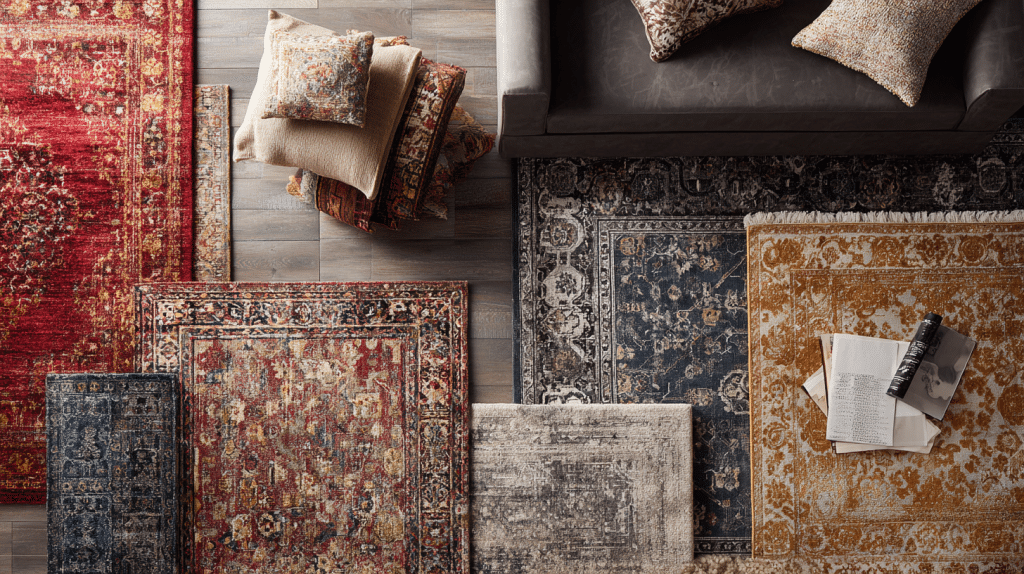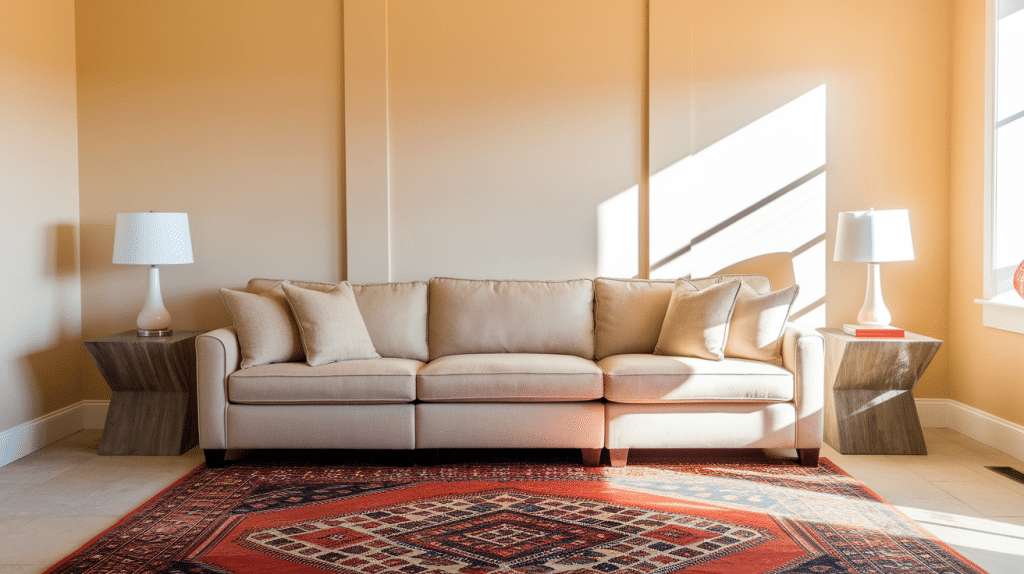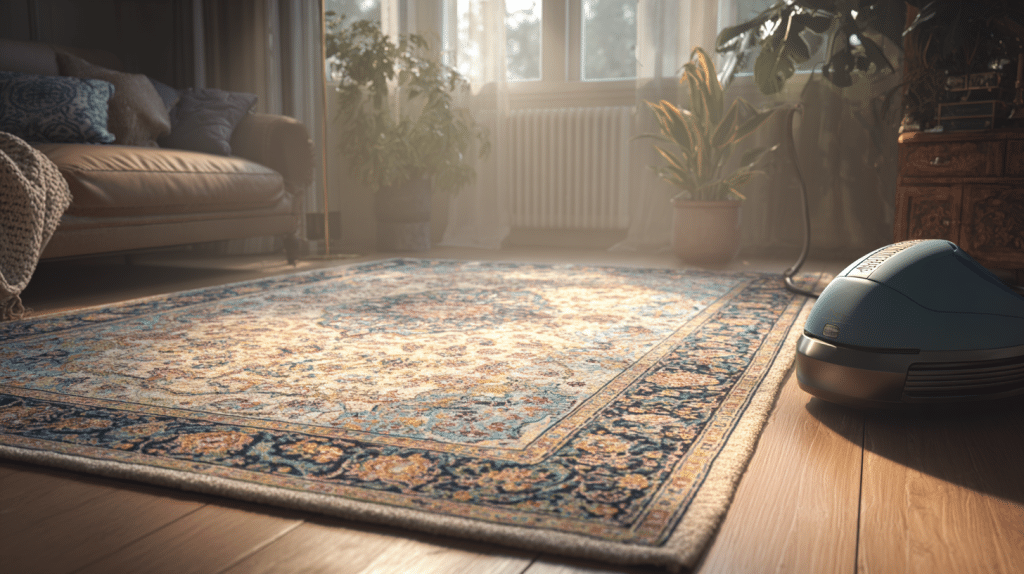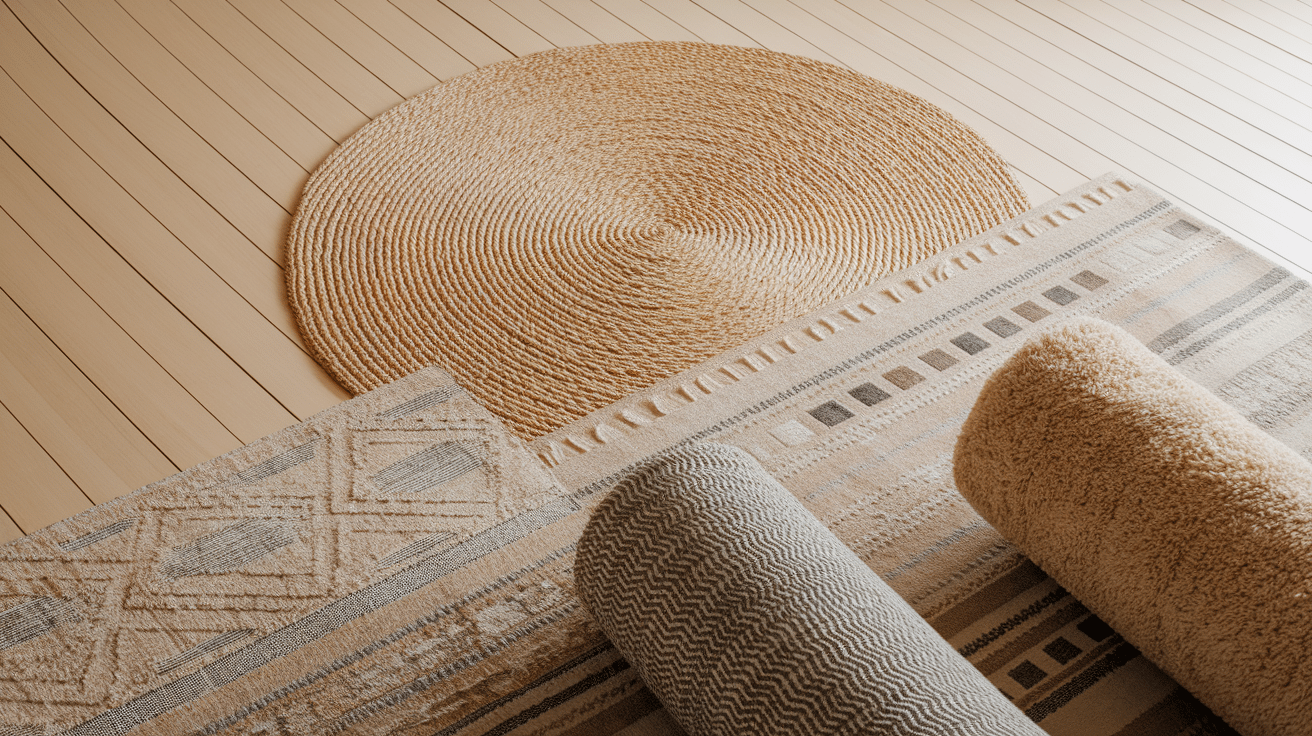Choosing the right rug size can significantly impact the overall look of your room. The perfect rug brings together all the elements in your space, making it feel balanced and complete.
When you get the size wrong, even the most beautiful rug can make your room look awkward or uncomfortable.
The right size rug can improve a room’s appearance, functionality, and comfort by creating harmony in the space.
It can make a small room feel larger, define different areas in an open floor plan, and provide a comfortable underfoot experience.
Proper rug sizing has a significant impact on everything from furniture placement to room flow, making it one of the most crucial design decisions you’ll make for your home.
Standard Rug Sizes in CM
Understanding standard rug dimensions helps you select the ideal size for any room in your home. These standard measurements are widely available and work well for most room layouts and furniture arrangements.
Standard Rug Dimensions by Size Category
Small Rugs
- 60×90 cm – Perfect for entryways, small bathrooms, or beside a bed
- 80×120 cm – Great for small spaces, under a desk, or in front of a sink
These compact sizes work well in tight spaces where you want to add warmth and style without overwhelming the area. They’re also budget-friendly options for renters or anyone wishing to test out a new color or pattern.
Medium Rugs
- 120×180 cm – Works well for bedrooms or smaller living rooms
- 140×200 cm – Ideal for dining areas with small tables or bedroom floors
Medium rugs offer the perfect balance between coverage and flexibility, making them popular choices for most homes. They provide enough surface area to anchor furniture while still leaving plenty of floor space visible around the edges.
Large Rugs
- 160×230 cm – Fits large living rooms or dining areas with bigger tables
- 200×300 cm – Perfect for spacious living rooms or open-plan areas
Large rugs create a sense of luxury and help define seating areas in bigger rooms. They work particularly well in open-plan spaces where you need to create visual boundaries between different functional areas.
Extra-Large Rugs
- 240×330 cm – Best for expansive living or dining rooms
- 300×400 cm – Ideal for vast spaces or commercial areas
Extra-large rugs make a bold statement and are best suited for spacious homes with high ceilings. They can completely change a room’s feel and are often used in luxury settings or commercial spaces like hotels and offices.
Area-Specific Size Recommendations
Different rooms in your home have different rug size needs based on their function and typical furniture layouts. Living rooms often require larger rugs to anchor seating areas, while bedrooms typically use medium-sized rugs for added comfort and warmth.
Are Standard Rug Sizes Consistent Worldwide?

Rug sizes can vary by region and manufacturer, making it essential to understand the different measurement systems used.
While many countries use the metric system, which is based on centimeters, some areas still rely on imperial measurements, which can create confusion when shopping internationally.
Different countries may have slightly different standard sizes based on local preferences and manufacturing traditions.
When shopping online or internationally, you might encounter measurements in feet and inches rather than centimeters. To convert inches to centimeters, multiply by 2.54 (for example, 5 feet = 152 cm).
Understanding both metric and imperial measurements helps you make better choices when shopping for rugs from different suppliers or regions.
This knowledge becomes instrumental when comparing prices across international retailers or when working with interior designers who may use different measurement systems.
Choosing the Right Rug Size for Your Space
Selecting the perfect rug size depends on your room’s layout, furniture placement, and how you use the space. Each area of your home has different requirements that affect which size works best.
| Room Type | Recommended Size | Placement Tips | Common Mistakes to Avoid |
|---|---|---|---|
| Living Room | 160×230 cm or 200×300 cm | Place under the front legs of furniture | Choosing a rug that’s too small for the seating area |
| Bedroom | 140×200 cm or 160×230 cm | Extend beyond the bed on three sides | Placing a tiny rug that only fits under the nightstand |
| Dining Room | 200×300 cm or 240×330 cm | Ensure chairs stay on the rug when pulled out | Getting a rug that’s too small for the table and chairs |
| Hallway | 60×240 cm or 80×300 cm | Leave space at both ends of the hall | Choosing a runner that’s too short for the hallway |
| Kitchen | 60×90 cm or 80×120 cm | Place in front of the sink or stove | Using a rug that’s too large for the workspace |
Practical Tips for Size Selection:
Measure your room and furniture before shopping for a rug to ensure a perfect fit. Consider leaving 30-60 cm of bare floor around the edges of the room for a balanced look.
In living rooms, ensure your rug is large enough to accommodate at least the front legs of your furniture.
Common Mistakes to Avoid When Choosing a Rug Size

Many people make sizing mistakes that can affect their room’s overall appearance and functionality. Learning about these typical errors helps you avoid them and choose the correct size from the start.
1. Too Small or Too Large
A rug that’s too small can make your room feel disjointed and cramped. It can also make your furniture appear to be floating in the space.
On the other hand, a rug that’s too large can overwhelm a room and make it feel cramped.
The key is finding the right balance for your specific room size and layout. A good rule of thumb is that your rug should be large enough to ground your furniture arrangement, but not so large that it dominates the entire floor space.
2. Not Considering Furniture Placement
Your furniture arrangement should guide your rug size choice. Consider if you want all furniture legs on the rug, just the front legs, or no legs at all. Each approach works in different situations, but you need to plan for it when choosing your rug size.
Consider how people will move through the space and if the rug will interfere with daily activities.
The placement should feel natural and improve the room’s functionality rather than creating obstacles or awkward traffic patterns.
3. Ignoring Room Shape
Room shape affects which rug size and shape work best. Rectangular rooms typically work well with rectangular rugs, while square rooms might benefit from square rugs.
Long, narrow spaces, such as hallways, require runner rugs in proportionate sizes.
Consider the architectural features of your room, such as built-in furniture, fireplaces, or bay windows, which can affect rug placement and size requirements.
These elements should work together with your rug choice to create a cohesive and balanced design.
Customizing Rug Sizes for Unique Needs
Sometimes standard sizes don’t work for your specific space or design vision. Custom rugs allow you to get precisely the size you need, though they typically cost more and take longer to receive.
When to Consider Custom Rugs
Custom rugs make sense when you have an unusual room layout, specific design requirements, or want a perfect fit for a unique space.
They’re also helpful when you need a size that falls between standard options or want a non-rectangular shape.
The investment in a custom rug often pays off in terms of a perfect fit and unique design possibilities. However, consider the longer lead times and higher costs when deciding if custom is the right choice for your project.
Working with Professionals
Interior designers and rug specialists can help you determine the best size for your space and guide you through the custom ordering process.
They can also help you avoid costly mistakes and ensure your rug fits perfectly in your room. Professional guidance becomes especially valuable when dealing with expensive custom rugs or complex room layouts.
Their expertise can save you time, money, and frustration while ensuring you get precisely what you need for your space.
How to Maintain Your Rug for Longevity

Proper care helps your rug last longer and look better, regardless of its size. Regular maintenance prevents dirt buildup and keeps colors vibrant, protecting your investment over time.
Basic Care and Cleaning
Vacuum your rug regularly to remove dirt and debris. Address spills immediately by blotting (not rubbing) with a clean cloth. Rotate your rug periodically to ensure even wear, especially in high-traffic areas.
Proper cleaning techniques vary depending on the material of your rug, so always refer to the manufacturer’s guidelines before using any cleaning products.
Regular maintenance prevents minor issues from becoming major problems that could require expensive professional restoration.
Protecting Your Investment
Use rug pads to prevent slipping and reduce wear and tear. Keep rugs away from direct sunlight to prevent fading. Consider professional cleaning annually or as needed, depending on the material of your rug and its level of use.
Quality rug pads not only protect your floors but also extend the life of your rug by reducing friction and movement.
Investing in proper protection and maintenance can help your rug maintain its appearance and value for many years to come.
Conclusion
Choosing the right rug size in centimeters is crucial for creating a well-designed, functional space. The perfect rug size depends on your room dimensions, furniture layout, and how you use the space.
Remember that standard sizes are suitable for most situations, but custom options are available when you need something more specific.
Take time to measure your rooms carefully, consider your furniture placement, and think about how you want your space to feel.
A well-chosen rug can change your room, making it more comfortable, stylish, and welcoming. When in doubt, it’s usually better to opt for a slightly larger size rather than a smaller one, as this creates a more luxurious and cohesive look.
Start by measuring your space and furniture, then use this guide to select the perfect rug size for your home.


